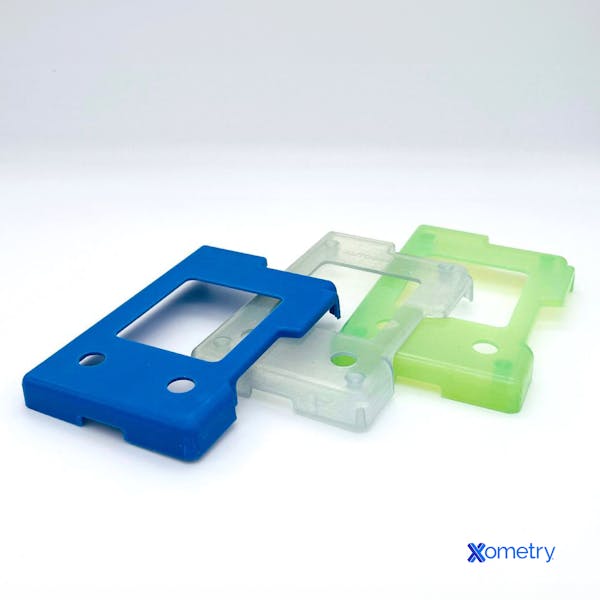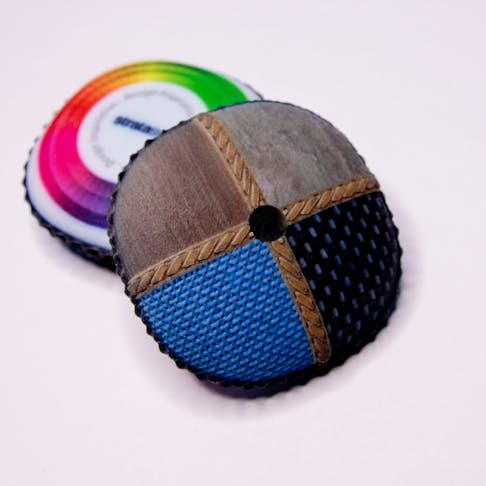What Is PolyJet™ 3D Printing?
The PolyJet™ 3D printing process makes use of an inlet-style printing head that can deposit multiple different materials from independent nozzles onto the build platform; as such PolyJet™ is a subclass of inkjet printing. The materials used in PolyJet™ printers are exclusively photopolymers. These 3D printed polymers will solidify when exposed to UV light. PolyJet™ parts also require support materials for large overhangs and internal volumes, which means some post-processing may be required. PolyJet is great for color 3D printing, as shown below:

Advantages of Using PolyJet™ Printing for Your Parts
The advantage of using PolyJet™ printers is that they can quickly manufacture “form, fit and functional” prototypes. These prototypes look and feel like the final product by making use of different colors and different materials. For example, a mock-up of a hand drill can be printed that has all the relevant colors and feel of the final part while also having a soft grip handle.
Types of PolyJet™ 3D Printers
A few types of PolyJet™ 3D printers include:
- Objet30: Used for printing rubber-like materials all the way up to a high-production-volume J4100 machine.
- J5 Medijet: A purpose-built machine for the medical industry.
- J5 Dentajet: A purpose-built machine for the dental industry.
PolyJet™ is a Stratasys trademark for a material jetting type 3D printing process. The company offers a wide range of PolyJet™ printers.
Applications of PolyJet™ 3D Printing
PolyJet™ 3D printing is widely used in the dental industry for creating accurate molds and for surgical aids in the medical industry. The method can also print multi-color and multi-material components in one step. As such, it is widely used for rapid prototyping, with the added benefits of retaining the final product's colors. Functional prototypes are also possible with materials like simulated polypropylene and ABS. An example of a PolyJet prototype is below:

Materials Commonly Used in PolyJet™ Printing
PolyJet™ printers make use of one category of material: photopolymers. These materials are deposited in a liquid form and are cured using UV light. Listed below are the materials used in PolyJet™ printing:
- Digital Materials: These materials are created by depositing up to seven different resins at once to create an acutely optimized material. Their physical and visual properties depend on the concentration, material type, and location of these individual droplets.
- Digital ABS Plastic: Digital ABS is a collection of photopolymer resins that have been selected to simulate the properties of traditional thermoplastic ABS. Digital ABS has comparable properties to standard ABS.
- Rubber-Like Materials: These are materials that exhibit rubber-like properties. Material hardness can vary from 25 to 75 on the shore A hardness scale.
- High-Temperature Materials: These are materials with a relatively high heat deflection temperature of 80 °C (with an additional post-cure process). While this is relatively low compared to standard high-temperature engineering thermoplastics, it is still sufficient for many hot air and water prototyping applications.
- Transparent Materials: PolyJet™ offers a transparent photopolymer called VeroClear, which simulates the mechanical and visual properties of PMMA (Acrylic/Perspex). For improved optical clarity, some post-processing, like polishing, is required. Translucent materials are also available if complete optical clarity is not required.
- Rigid Opaque Materials: These materials have properties comparable to acrylic and, as such, are best suited to light-duty applications that are not exposed to shock or cyclic loads.
- Simulated Polypropylene Materials: These materials have almost double the impact resistance of other PolyJet™ materials, making them better suited to mechanical applications. They can also simulate the capacity of polypropylene for living hinges and snap-fit assemblies.
- Biocompatible Materials: These materials are suitable for long-term direct skin contact and short-term muscular membrane contact.
How PolyJet™ Printing Works
PolyJet™ printing works by depositing multiple drops of photopolymer on the build platform and immediately passing a UV light source over the layer. This solidifies the layer, after which the build platform moves down by one layer, and the next layer is deposited on top of the previous one. PolyJet™ printers have multiple independent printheads, which allow them to print multi-color and multi-material parts.
PolyJet™printers are among the fastest 3D printers. A PolyJet™ printer works much like an inkjet printer in the sense that it deposits a layer of photopolymer onto the building line as if it was printing an image of that layer of the part. PolyJet™ printers can print the fastest if only one resin is used for a part.
The Standard Accuracy of PolyJet™ Material
PolyJet™ printers can print with excellent accuracy, with layer heights ranging from 14 microns to 55 microns. The exact level of accuracy depends on the machine and the print speed. The highest levels of accuracy are achievable at the slowest print speeds. The dimensional accuracy of the part depends on the part size as listed below:
- Smaller than 100 mm: +- 100 microns
- Larger than 100 mmm: +- 200 microns or 0.06 % of the part length (whichever is larger)
The Cost of PolyJet™ 3D Printers and Parts
PolyJet™ printers are some of the most advanced printers on the market and are regarded as industrial tools. As such, it should be no surprise that they are generally very costly when compared to other plastic 3D printers. A typical PolyJet™ printer can range anywhere from $6,000 to $75,000. PolyJet parts can be 3D printed with Xometry on demand at reasonable cost. You can get an instant quote any time.
Summary
Xometry provides a wide range of manufacturing capabilities including CNC machining, 3D printing services (including PolyJet 3D printing), injection molding, laser cutting, and sheet metal fabrication. Get your instant quote today.
Copyright and Trademark Notices
- PolyJet™ is a trademark of Stratasys, Prairie, MN.
Disclaimer
The content appearing on this webpage is for informational purposes only. Xometry makes no representation or warranty of any kind, be it expressed or implied, as to the accuracy, completeness, or validity of the information. Any performance parameters, geometric tolerances, specific design features, quality and types of materials, or processes should not be inferred to represent what will be delivered by third-party suppliers or manufacturers through Xometry’s network. Buyers seeking quotes for parts are responsible for defining the specific requirements for those parts. Please refer to our terms and conditions for more information.


